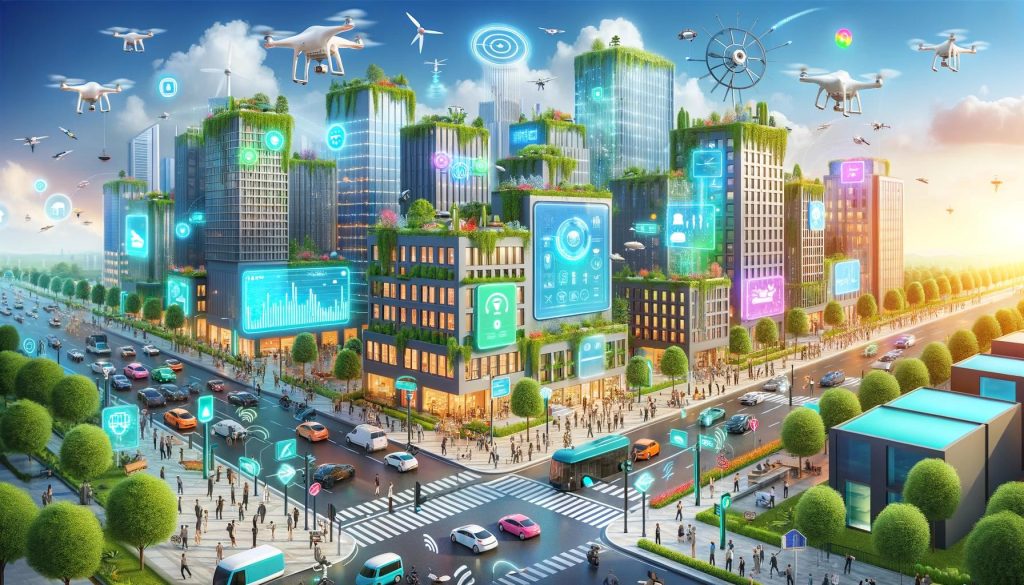
What exactly is a smart city? Smart cities are a creative way for towns around the world to deal with the complicated problems they face and the growing number of people living in them. These city centers improve efficiency, sustainability, and people’s quality of life by using data-driven solutions and state-of-the-art technology. Here we take a closer look at “smart cities,” breaking them down into their component parts and discussing their pros and cons.
So, how does a smart city really function?
A “smart city” is an extremely developed metropolitan region that gathers data via the use of a wide variety of electronic devices and sensors. With this information, the city can better manage its services, assets, and resources. And this improves its operations as a whole. In order to keep tabs on and control a number of critical sectors, the city collects and analyzes data collected from residents, gadgets, and structures. Among these critical sectors are waste management, criminal investigations, urban forestry, water supply networks, power plants, and transportation and traffic systems.
A “smart city” is one that combines digital infrastructure with a wide range of physical objects linked together by an IoT network. Improved citizen engagement and operational efficiency are two goals of this integration. With the use of smart city technologies, municipal authorities may have two-way conversations with the public and the city’s physical systems. It makes it possible to track the city and its changes in real time. With the use of ICT, urban services may become more interactive, efficient, and high-quality while using fewer resources. Citizens are more actively involved with the government as a result.
A smart city revolves around these factors
An essential component of any smart city is its network of linked digital technologies, which allow for the effective administration of services and resources. Transportation, energy, healthcare, and public safety are just a few of the many domains covered by these technologies. Smart cities provide real-time monitoring and response to a wide range of urban life characteristics via the integration of sensors, data analytics, and communication networks. An integral part of every smart city is its commitment to environmental responsibility.
Cities may lessen their impact on the environment and encourage sustainable habits by establishing smart energy networks, waste management systems, and environmental monitoring programs. Reduced traffic and pollution are additional benefits of smart transportation technologies, including optimized public transportation and intelligent traffic control.
What are the benefits of smart cities?
- Improved living standards
A smart city is one that actively works to improve its citizens’ standard of living. One example is the potential for smart healthcare systems to improve resource allocation, personalization of treatment, and remote patient monitoring. Additionally, predictive policing methods, advanced monitoring systems, and coordinated emergency responses may all improve public safety. The advantages of smart cities extend beyond mere technological progress.
- These cities are hotspots for economic growth and job creation
Economic development and new employment opportunities may flourish in “smart cities” that encourage a spirit of innovation and entrepreneurship. In order to diversify and flourish economically, it is necessary to have high-speed internet, digital infrastructure, and legislative frameworks that are conducive to attracting enterprises and entrepreneurs.
- Enhanced collaboration
In order to address complicated urban problems, smart cities also promote teamwork among many stakeholders, such as people, corporations, and government agencies. Improvements to infrastructure, as well as increased social participation, technology uptake, and economic growth, are all objectives of this cooperative strategy.
Are there any concerns?
There are significant factors to take into account, even if smart cities have great potential. The collection and use of vast amounts of data has given rise to concerns about people’s private rights and the potential for cyber dangers. This makes data security and privacy major issues. Another important step in avoiding the widening of economic gaps is making sure everyone has a fair chance to participate in smart city projects.
Good examples of smart city initiatives
- Singapore’s Smart Nation Initiative
A technological behemoth at the forefront of smart city innovation, Singapore is more than just a city-state. In an effort to make city life better, make things more sustainable, and increase economic development, Singapore has launched the Smart Nation Initiative. With its state-of-the-art waste management technologies and smart traffic management systems, Singapore is leading the way for smart cities throughout the globe.
- The Smart City Solutions of Barcelona
Not only is Barcelona the lively capital of Catalonia, famous for its beautiful buildings and lively culture, but it is also known for its smart city solutions. Smart lighting, optimized waste management, and efficient public transit are just a few of the city’s ongoing efforts. A more sustainable and interconnected future is possible because of Barcelona’s pioneering work in incorporating technology into many facets of city life.
How will smart cities evolve in the future?
1. Emerging Trends and Innovations
The prospects for smart cities are more promising than ever before due to the exponential growth of technology. New developments in data analytics, the Internet of Things (IoT), and artificial intelligence are having a profound impact on city planning and administration. These advances, which include smart grids and driverless cars, are changing the face of cities and opening up new opportunities for sustainability and efficiency.
2. Smart City Concepts’ Global Expansion
The concept of “smart cities” is rapidly spreading around the globe, not limited to a small number of innovative places. Cities throughout the world, from Tokyo to New York, are using smart technology to solve urban problems and enhance the lives of their citizens. There will be other revolutionary developments that reshape urban life, work, and pleasure as the smart city revolution gains momentum.
3. Effects on the Environment and Eco-Friendly Solution Findings
Reducing environmental effects and supporting green solutions is one of the key ideas of smart cities, with an emphasis on sustainability. Smart cities are putting an emphasis on environmentally beneficial practices, such as renewable energy sources and energy-efficient structures, to make urban areas healthier and more pleasant to live in. Smart towns are lowering their carbon footprint and demonstrating sustainable urban development practices by adopting green technology and programs.
4. Making Sure We Can Handle Difficult Situations
Resilience is crucial for smart city success in today’s uncertain environment. In order to better handle crises and catastrophes, smart cities integrate disaster management systems, emergency response procedures, and strong infrastructure. Assuring the safety and well-being of people and swiftly recovering from obstacles like pandemics and natural catastrophes are two of the main goals of smart city design.

